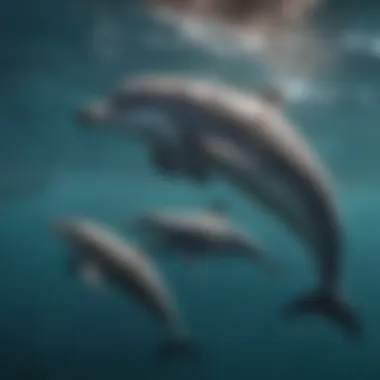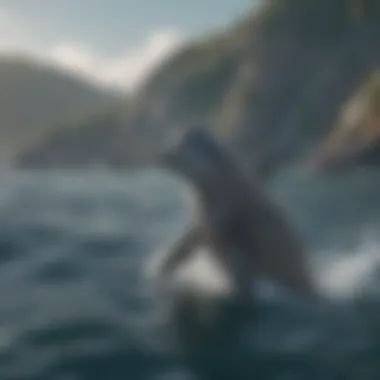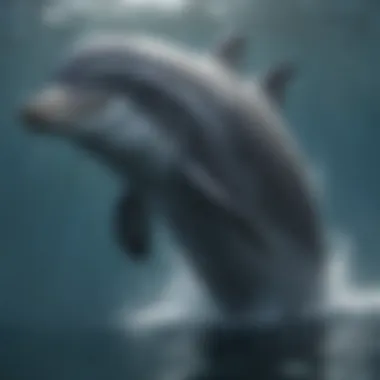Exploring the Natural Habitat of Bottlenose Dolphins


Nature Topic Overview
Bottlenose dolphins are fascinating creatures that glide gracefully through the waters of oceans and coastal areas. Understanding their natural habitat gives us a glimpse into the wonderful world they inhabit. These dolphins prefer warmer waters, often staying close to shorelines where they can find plenty of food and have space to socialize. In picking their environments, they show a clear preference for areas with mangroves, estuaries, and coral reefs. But what makes these specific places so ideal for them? As we dive into the depths of their ecological world, we’ll discover how their habitat is more than just a home; it’s a complex ecosystem that they are adapted to thrive in.
Fun Facts and Trivia
Did you know that bottlenose dolphins have a unique way of communicating with each other? They use whistles and clicks that can be heard underwater, which helps them keep in touch even when they're swimming apart! Here are some more intriguing tidbits:
- These dolphins are known to have excellent memories, able to remember their friends for many years.
- An adult bottlenose dolphin can weigh between 300 to 1,400 pounds, making it quite a hefty sea creature!
- They can swim at speeds of up to 20 miles per hour when they want to race!
Using visuals like pictures of their habitats or videos showing them playing can help young learners grasp the concept better.
Wildlife Explorations
The bottlenose dolphin might be the star of the show, but it shares its habitat with a variety of other species, each playing an important role in the ecosystem. For instance:
- Sea turtles often share the coastal waters. They help maintain the health of seagrass beds, which benefits both dolphins and their habitats.
- Colorful fish like clownfish and parrotfish are often found around coral reefs where bottlenose dolphins hunt for smaller fish.
Engaging children through interactive quizzes or puzzles about these companions can enhance their understanding. A fun challenge could be identifying different fish species that bottlenose dolphins might encounter!
Environmental Awareness
As curious and intelligent beings, bottlenose dolphins face threats from human activity, including pollution and overfishing. It’s crucial to understand the importance of conserving their habitat, not just for them but for the entire biosystem that relies on clean water and healthy environments. In fact, did you know that:
Pollution can disrupt the food chain, leading to consequences not just for dolphins but for many other animals, making conservation efforts vital.
Children can participate in conservation by:
- Reducing plastic use to keep oceans clean.
- Supporting local marine conservation projects.
- Learning about ways they can preserve water quality at home.
DIY Nature Activities
Encouraging kids to connect with nature can be both educational and fun! Here are simple yet engaging activities:
- Create a Dolphin Habitat Diorama: Use cardboard, craft supplies, and imagination to build a scene that reflects the natural home of bottlenose dolphins.
- Outdoor Exploration: Organize a beach clean-up event or visit a local aquarium to see dolphins and their habitats firsthand.
Providing clear instructions and materials can help children create their projects effectively.
By understanding and protecting the habitat of bottlenose dolphins, young learners not only become educated about marine life but also active participants in the preservation of our planet's ecosystems.
Prelude to Bottlenose Dolphins
Bottlenose dolphins are captivating creatures, embodying a dynamic blend of intelligence, social behavior, and adaptability. Understanding these marine mammals is not just for enthusiasts, but it holds significance for everyone. Knowing about bottlenose dolphins helps foster appreciation for marine life, and improves awareness of the delicate balance within ocean ecosystems.
This article explores various aspects of bottlenose dolphins’ habitats, their role within ecosystems, and the ongoing threats they face. It opens a window for young learners, parents, teachers, and care-givers to grasp the wonders of these dolphins in a way that connects to their everyday lives.
Classification and Characteristics
Bottlenose dolphins, scientifically known as Tursiops truncatus, belong to the family Delphinidae which includes other dolphin species too. They are one of the most recognized dolphins, often seen performing in aquariums or jumping in the surf along the coast. These dolphins are typically grey, with lighter underbellies, but they can come in various shades of grey, depending on their environment.
Their streamlined bodies enable them to swim swiftly through water, helping them pursue food and evade predators. Adult bottlenose dolphins can range anywhere from 8 to 12 feet in length. An interesting tidbit is that they possess a layer of blubber that keeps them warm in cooler waters.
- Physical Features:
- Skin: Smooth and rubbery, aids in hydrodynamics.
- Dorsal Fin: Curved and prominent, often acting as a stabilizer.
- Echolocation: They use this capability to locate prey and navigate murky waters.
Cognitive Abilities and Social Structure
What sets bottlenose dolphins apart from many other species is their remarkable cognitive abilities. These dolphins exhibit complex behaviors, including play, problem-solving, and even self-recognition in mirrors, which hints at a sophisticated level of consciousness.
Bottlenose dolphins are social creatures, living in groups called pods. These pods usually consist of family members and can range from a few dolphins to dozens. Their social structures are often matriarchal, meaning older females tend to lead and make decisions. Social bonds among dolphins are intricate, marked by vocalizations, physical contact, and cooperative hunting practices.
- Key Social Behaviors:
- Communication: They are vocal animals using a range of clicks, whistles, and body language.
- Cooperative Hunting: They often hunt in teams, working together to herd fish.
- Playful Interactions: Dolphins are known for surfing the waves and leaping out of the water.
In essence, understanding bottlenose dolphins offers a glimpse into their fascinating world, illustrating their survival strategies and emphasizing the importance of conserving their habitats.


Natural Habitat Overview
Definition of Habitat
A habitat is the place where an organism lives and thrives. For bottlenose dolphins, this means any area in the ocean or near the coast where they can find food, socialize, and avoid danger. While this might sound straightforward, the term "habitat" encompasses a lot of factors. It’s not merely a physical space; it’s defined by the availability of resources like prey, the physical conditions like water temperature and salinity, and the interactions with other organisms. In essence, their habitat is their world, where various elements converge to create a suitable home.
Habitat Types
Bottlenose dolphins inhabit various marine environments that can be categorized mainly into three types: coastal waters, open oceans, and estuaries. Each of these habitats comes with distinct features that support their life and behavior.
Coastal Waters
Coastal waters are among the most favorable habitats for bottlenose dolphins. This area, where the ocean meets the land, is typically shallow and rich with nutrients. One key characteristic of coastal waters is their proximity to land, providing ample opportunities for dolphins to forage close to shore. This makes it a popular choice for both dolphins and those of us who enjoy watching them.
- Food Availability: Coastal zones are teeming with fish and other marine life, creating a buffet that dolphins are eager to dive into.
- Protection: In these areas, dolphins can find shelter from rough open ocean conditions, making it a safer spot for socializing and raising young.
However, it's crucial to note that coastal waters can sometimes be subject to high levels of human activity, which may impact dolphin populations.
Open Oceans
The open oceans present a contrasting but equally important habitat. This vast expanse of water is less explored and provides unique opportunities for dolphins. A significant aspect of open oceans is their scale and depth, allowing for extensive travel and exploration.
- Diverse Diet: Dolphins can find various prey types, especially schooling fish that thrive in deeper waters.
- Freedom of Movement: The open ocean allows dolphins the freedom to migrate and explore, which is essential for social interactions.
Nevertheless, the open ocean isn’t without its challenges. It can be difficult to find food, and the distance from land may expose dolphins to greater dangers, including boats.
Estuaries
Estuaries, the areas where fresh water from rivers meets the saltwater of the oceans, serve as critical habitats for bottlenose dolphins. One remarkable feature of estuaries is their richness in biodiversity. With water mixing from different sources, these zones provide unique ecological niches.
- Nursery Grounds: These areas serve as nurseries for many marine species, providing a safe haven for younger dolphins to grow and develop.
- Nutrient-Rich: The mixing waters are often filled with nutrients, making it a hive of activity and an ideal feeding ground for dolphins.
However, estuaries are often under pressure from urban development and pollution, presenting a significant threat to the dolphins that rely on them.
By understanding these varied habitats – coastal waters, open oceans, and estuaries – we can appreciate the intricate connections that bottlenose dolphins maintain with their environments. Each habitat contributes uniquely to the dolphins’ survival, and recognizing their importance can inspire efforts to protect these critical ecosystems.
Geographical Distribution
Understanding the geographical distribution of bottlenose dolphins sheds light on how they adapt to varying environments. This section not only highlights where these dolphins can be found but also emphasizes the significance of these habitats to their survival and social dynamics. Knowing their preferred elocations helps scientists and conservationists safeguard these areas, ensuring the well-being of this intelligent species.
Global Presence
Bottlenose dolphins are quite the world travelers, hanging out in warm and temperate waters across the globe. They can be spotted in the Atlantic, Pacific, and Indian Oceans. However, they're not picky when it comes to their surroundings; they often choose coastal waters, bays, and estuaries to call home. These locations provide a rich buffet of fish and squid, which are their favorites. Their global presence indicates adaptability, as they thrive in various marine environments, making them one of the most studied dolphin species.
Variability by Region
The habitat of bottlenose dolphins varies significantly from one region to another. Each area offers unique characteristics that influence their behavior, social structures, and ecological interactions.
Tropical Regions
In tropical regions, the water is teeming with colors and life. The warm climate creates a paradise for bottlenose dolphins. Here, they revel in the calm, shallow waters, which are typically filled with a variety of fish species. The richness of food sources in these areas is a key factor that makes them highly attractive habitats. However, tropical waters can also be crowded with boats and human activities, which pose challenges for these dolphins.
Temperate Regions
Shifting to temperate regions, dolphins find themselves in zones where seasons change. This variability means they must adapt to colder waters during winter months. Temperate areas provide diverse habitats including rocky coastlines, sandbanks, and estuaries which serve as excellent spots for hunting. The food found here changes with the seasons, so bottlenose dolphins must stay sharp to catch their meals. The challenge also lies in the changing environment, as pollution and urban development can affect their habitats significantly.
Polar Areas
In polar areas, bottlenose dolphins usually venture less often, but they don’t completely shy away from cold waters. These regions can present extreme conditions.While some dolphins travel to ice-covered waters, they typically stick to edges where the warmth meets the cold. They encounter unique prey like seals, which can be a great source of energy. However, very cold temperatures can strain their feeding patterns and migratory routes. Living in these challenging atmospheres showcases the remarkable adaptability of dolphins, standing as a testament to their resilience.
"Bottlenose dolphins are fascinating creatures, showcasing incredible adaptability across different regions."
The geographical distribution of bottlenose dolphins serves not just as a map of their habitats but also as a guide to understanding environmental needs and threats. Recognizing the features of their global presence allows us to emphasize conservation measures and highlights the urgent necessity to protect their homes.
Ecological Significance
The significance of studying the ecological role of bottlenose dolphins extends far beyond mere curiosity about these captivating creatures. Understanding how they fit into their marine environments gives insight into the health and stability of ocean ecosystems. Bottlenose dolphins are not just passive inhabitants of the waters they roam; they play an active role in maintaining the ecological balance. The symbiosis between these dolphins and their habitat underscores the importance of both in fostering a thriving marine community.


Role in Marine Ecosystems
Bottlenose dolphins are often considered sentinel species, meaning that their presence, health, and behavior can provide crucial information about the marine environments in which they live. Their foraging habits help regulate fish populations. When dolphins hunt, they often target specific species, which in turn allows other species to flourish. This balance prevents overpopulation and depletion of prey species, ensuring a healthy marine food web.
Additionally, dolphins contribute to nutrient cycling in the oceans. When they consume fish and other marine animals, the waste they produce enriches the surrounding waters with nutrients. This process supports phytoplankton growth, which forms the basis of the oceanic food chain.
Interactions with Other Species
- Prey Relationships
Bottlenose dolphins have complex prey relationships with the species they feed on, which is primarily composed of fish and squid. The dolphins' hunting strategies vary according to prey availability, demonstrating adaptability and intelligence. This unique interaction leads to a more organized predator-prey dynamic and influences the behaviour of prey species. A key characteristic of these relationships is the role of bottlenose dolphins as apex predators. By keeping prey populations in check, they help maintain biodiversity within the ecosystem.
"Bottlenose dolphins are not merely hunters; they are critical architects of their marine world, shaping ecosystems just by being themselves."
However, the methods dolphins use to catch their food can also impact their habitat. For example, their technique of herding fish into tight groups, known as herding, creates opportunities for both dolphins and other predators, illustrating the interconnectedness of marine life.
- Predator Dynamics
Dolphins also face predators of their own, although they are typically at the top of their food chain. Species like sharks are known to prey on younger or sick dolphins, emphasizing the fluid dynamics of predator-prey interaction in marine environments. This dual aspect of being both predator and prey highlights a significant feature: the vulnerabilities inherent in dolphin populations. While it showcases their adaptability, it also underscores the need for conservation measures, as disturbances in their habitat can lead to increased predation or reduced food availability.
In summary, the ecological significance of bottlenose dolphins transcends their own existence; it encompasses the delicate threads that bind animal interactions within their environments. Recognizing their role in marine ecosystems expands our understanding of ocean health and guides us toward better management practices in conservation efforts.
Habitat Preferences
When we talk about the habitat preferences of bottlenose dolphins, we're diving into aspects of their world that truly make them thrive. Each dolphin, while playful and curious, also has specific needs that help them flourish in the deep blue sea. Understanding these preferences is important because it helps us protect their environments, ensuring their survival in changing conditions.
Temperature and Salinity Requirements
Bottlenose dolphins have a knack for finding the right temperatures and salinity levels in the water. Most of these dolphins prefer warmer waters, typically between 20°C and 30°C (68°F to 86°F). Such temperatures provide not just comfort but also influence their feeding habits and breeding cycles. Imagine swimming on a beach where the water feels just right—you wouldn’t want it too cold or too warm, right?
Salinity, or the saltiness of water, is another critical factor. Bottlenose dolphins are generally found in marine environments where salinity ranges from 30 to 35 parts per thousand. This range helps keep them healthy and allows for the types of prey they typically hunt. If the salinity varies too much, the dolphins might struggle to find food, which could impact their survival.
Depth and Substrate Preferences
When it comes to depth, bottlenose dolphins often prefer shallow coastal waters—often you can spot them in depths of less than 100 meters (328 feet). These waters are typically rich with fish and other marine life which makes it a buffet for the dolphins. Just think of a shallow lagoon where the sun warms the sand; it's an ideal place for both feeding and socializing.
The substrate also plays a role. Bottlenose dolphins can be found resting or hunting near sandy bottoms as well as rocky areas. Each substrate offers something different—sandy bottoms might hold more shrimp and fish, while rocky areas can be teeming with squid and other treats. This variety gives them numerous foraging opportunities and helps sustain their adaptable nature.
"Bottlenose dolphins are like culinary explorers of the ocean, always seeking out new spots that satisfy their tastes and needs."
In summary, diving into the habitat preferences of bottlenose dolphins gives us a clearer picture of their lives beneath the waves. By understanding what they need in terms of temperature, salinity, depth, and substrate, we can take meaningful steps toward ensuring their habitats are preserved. This knowledge not only aids in conservation efforts but also encourages awe and respect for these intelligent marine mammals.
Threats to Habitat
Understanding the threats to the habitat of bottlenose dolphins is crucial for their conservation. As human activities expand, dolphins face numerous challenges that can impact their ecosystems and survival. In this section, we will explore these threats in detail, highlighting pollution and fishing practices, as well as the overarching issue of global warming. This is essential not only for dolphins but for the health of marine ecosystems as a whole.
Human Impact on Marine Habitats
Pollution
Pollution is a pressing issue affecting marine environments. It can come in many forms, such as plastic waste, oil spills, and chemical runoffs. Each of these types of pollution contributes significantly to the detriment of marine habitats, including those frequented by bottlenose dolphins.
The key characteristic of pollution is its pervasive nature. It often originates from land, flowing into the ocean and affecting both the water quality and the marine life that inhabit those waters. This contamination can lead to reduced fish populations, which in turn affects the food supply for dolphins.
An important aspect of this discussion is the presence of microplastics. These tiny plastic particles are increasingly found in ocean waters and can enter the food chain, posing health risks to dolphins and other marine organisms.
Pollution presents several disadvantages in relation to the habitats of bottlenose dolphins. It can lead to habitat degradation, altering the ecosystems where they typically thrive. As dolphins rely on clean waters to hunt and socialize, pollution’s impact can severely limit their natural behaviors and survival rates.
Fishing Practices
Fishing practices can significantly influence dolphin populations and their habitats. The use of certain fishing methods, such as gillnets and trawling, can unintentionally trap dolphins. This accidental bycatch not only harms individual dolphins but also disrupts the overall population dynamics.
One key characteristic of fishing practices is their impact on the local marine life balance. When dolphins are caught as bycatch, it affects not only them but also their prey, leading to an imbalance in the ecosystem.
A unique feature of this issue is that fishing practices can also influence dolphin migration patterns. As fish populations dwindle due to overfishing, dolphins may be forced to travel further in search of food, which can lead to increased energy expenditure and stress on their populations.
The advantages of examining fishing practices include raising awareness about sustainable methods that protect dolphin habitats. Encouraging practices like selective fishing gear can reduce bycatch and promote healthier marine ecosystems. This knowledge is significant in shaping more responsible fishing regulations and ensuring the dolphins’ well-being.
Global Warming and Its Effects
Global warming is perhaps the most significant long-term threat facing bottlenose dolphins and their habitats. As sea temperatures rise, the marine environment experiences shifts that can alter food availability and influence dolphin behavior. Changes in ocean currents also play a role; as currents shift, so too do the ecosystems and species that rely on them.


Additionally, rising sea levels pose a threat to coastal habitats where dolphins often seek shelter or hunt for food. Figuring out how these shifts impact ecosystems can help in conservation efforts. There’s a pressing need for ongoing research to understand these changes and their ramifications on marine life, especially for species whose adaptabilities are already tested.
"Every ripple in the ocean affects the whole waterscape; when one species struggles, it can create a domino effect that impacts all."
Conservation Efforts
Conservation efforts play a crucial role in ensuring the survival of bottlenose dolphins and protecting their habitats. These efforts are not just about saving the species; they contribute to maintaining the integrity of marine ecosystems. With increasing threats from human activities and climate change, understanding how we can support conservation initiatives is more essential than ever.
Protected Marine Areas
One significant approach to conservation is the establishment of protected marine areas (PMAs). These zones are designated portions of the ocean that are managed to preserve marine and coastal biodiversity. They serve as safe havens for dolphins and other marine life, limiting human impact in these areas. Here's why PMAs are vital:
- Safe Habitat: PMAs offer a refuge from fishing, shipping, and pollution, allowing dolphins to thrive in cleaner, healthier waters.
- Biodiversity Protection: These areas protect not only dolphins but also a variety of marine species, ensuring that the entire ecosystem remains balanced.
- Research Opportunities: Protected zones provide scientists and researchers a place to study dolphin behavior and ecology without the interference of human activity.
Implementing these areas can lead to notable recoveries in dolphin populations, showcasing how conservation actions can yield significant results.
"Marine protected areas are like insurance for our oceans, safeguarding the future of marine life for generations to come."
Community Involvement and Education
Community involvement is a cornerstone of effective conservation efforts. People who engage with local wildlife develop a sense of ownership and responsibility towards their preservation. Educating communities about the importance of bottlenose dolphins and their habitats helps inspire action at the grassroots level. Here are some ways community involvement and education contribute:
- Awareness Programs: Educational initiatives can raise awareness among children and adults about the challenges faced by dolphins. Schools can implement marine education programs where students learn about ocean conservation.
- Volunteer Opportunities: Local communities can participate in clean-up events, allowing families to work together while fostering a connection with nature. This not only benefits the environment but also strengthens community ties.
- Reporting and Monitoring: Citizens can help in monitoring dolphin populations and reporting any harmful activities, such as pollution or illegal fishing, to authorities, adding an extra layer of protection.
Saving bottlenose dolphins requires a collaborative effort. When local communities understand their role in protecting these creatures, they can make a significant impact. By joining forces, we can help ensure that these intelligent and social marine mammals continue to flourish in their natural habitats.
Adapting to Human Presence
Understanding how bottlenose dolphins adapt to human influence is essential for their survival. These remarkable creatures have shown a unique ability to modify their behavior in response to the changing conditions of their habitats due to human activities. By examining these adaptations, we gain insight into their resilience and also highlight the complexities of marine conservation efforts.
Behavioral Adaptations
Bottlenose dolphins are known for their intelligence, which helps them adjust to the presence of humans in their environments. For instance, they have been observed altering their foraging techniques in areas with heavy boat traffic. Instead of hunting alone, they might gather in groups, increasing their chances of successfully capturing prey while simultaneously navigating the hustle and bustle of human activities.
Another key adaptation can be seen in their vocalizations. In noisy environments, like marinas or areas with frequent ship movements, these dolphins tend to increase the frequency of their clicks and whistles to communicate effectively. It's almost like they're raising their voices above the sound of the chaos around them! Unlike in quieter waters, this adjustment could mean the difference between finding food or going hungry.
Moreover, they have displayed an interesting proficiency in using manmade structures for shelter or hunting grounds. For example, dolphins have been seen swimming close to piers, where they can exploit the shadows cast by boats to attract fish that are drawn to the shade. This is a clever tactic that perfectly blends natural instincts with the opportunities presented by human construction.
"Dolphins' ability to adapt is a testament to their intelligence and versatility, showcasing how they can thrive even amid the pressures placed by human interventions."
Changing Migration Patterns
Migration is crucial for many species, and bottlenose dolphins are no different. However, human activities have significantly influenced their migratory habits. Traditionally, these dolphins moved freely between different habitats based on seasonal changes and prey availability. Nevertheless, with increasing coastal development, shipping routes, and pollution, some populations have had to adjust their migratory patterns.
For instance, certain groups have started to remain in specific coastal areas longer than they normally would have due to the decline of suitable habitats elsewhere. This is concerning because it can lead to over-reliance on a few regions, which may not sustainably support their needs over time.
In addition, some dolphins may now avoid heavily industrialized areas altogether, opting instead for regions that are less disturbed by human presence. This alteration in migration patterns could potentially lead to genetic segregation over time, as their populations become more isolated from one another.
In summary, bottlenose dolphins continuously find ways to navigate a world where humans are an increasing presence. Their behavioral adaptations and changing migration patterns are important not only for their survival but also for maintaining the health of marine ecosystems. As we learn more about these adjustments, we can better understand how to protect these magnificent marine mammals in a world that often seems at odds with nature.
End and Future Research
As we round off our exploration into the habitat of bottlenose dolphins, it’s important to take a moment to reflect on why this subject matters. Understanding how these creatures interact with their environments not only gives insight into their daily lives but also highlights the delicate balance they maintain with our oceans. In a world increasingly shaped by human activity, recognizing the significance of habitats is crucial for the survival of these dolphins and the health of marine ecosystems.
Importance of Continued Study
Continued research on bottlenose dolphins is vital for several reasons. First, the more we learn about their habitat, the better we can protect it. Dolphins thrive in specific conditions, and even slight changes in temperature or pollution levels can impact their well-being. Researchers can develop guidelines for conservation strategies that specifically address these needs.
Second, as children and families learn about these wonderful creatures, it cultivates an appreciation for marine life and natural environments. This understanding encourages young minds to care about protecting ocean ecosystems. By keeping the dialogue open, schools and communities can inspire future generations to be stewards of the environment.
"In the end, what we protect in the ocean, we protect for the dolphins - and for ourselves."
- Marine Conservationist
Learning about bottlenose dolphins is more than scientific curiosity; it's about the future of our shared planet.
Implications for Conservation Policies
The implications for conservation policies stemming from this research are significant. If data shows that bottlenose dolphins require healthy estuaries, coastal areas, and open oceans for their survival, then policy-makers must prioritize these regions in their environmental regulations.
- Collaborative Efforts: Local fisherman, conservationists, and policy-makers need to work hand-in-hand. By understanding traditional fishing practices that might impede dolphin habitats, solutions can be crafted that respect both dolphin needs and fisherman livelihoods.
- Educating Communities: Efforts should be made to educate communities about the impact of pollution and human activity on dolphin habitats. This knowledge can lead to community-driven initiatives to reduce waste entering waterways.
- Global Collaborations: Bottlenose dolphins don’t recognize national borders. Conservation policies need international cooperation since these mammals may travel vast distances across different waters. As countries align their regulations, dolphins will have a higher chance of thriving.
Thus, studying bottlenose dolphins isn’t just about understanding them; it’s about making informed choices that influence policy changes aimed at safeguarding their future and the health of marine ecosystems.







